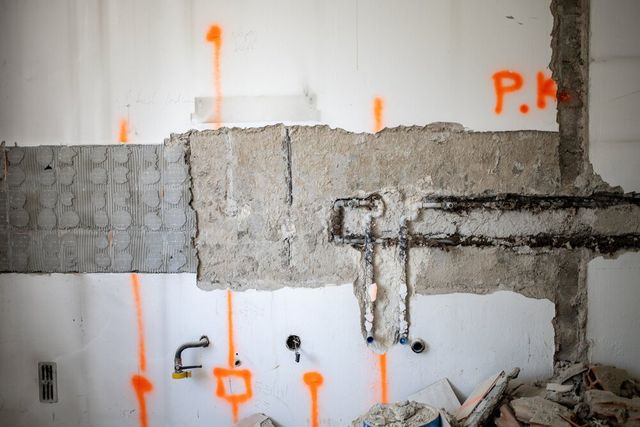Enhance Construction Security with Expert Concrete Scanning
Enhance Construction Security with Expert Concrete Scanning
Blog Article
Elevate Your Building Process With the Strategic Insights of Concrete Scanning for Improved Efficiency
One such technology that has changed the construction industry is concrete scanning. By utilizing the strategic understandings given by concrete scanning, construction specialists can unlock a world of improved productivity and structured processes.

Advantages of Concrete Scanning
Enhancing job efficiency and safety and security, concrete scanning uses a non-destructive method for identifying concealed objects within concrete frameworks. By making use of technologies such as ground-penetrating radar (GPR) and concrete x-ray imaging, building and construction teams can precisely find rebar, post-tension cable televisions, electrical channels, and various other obstructions before exploration, cutting, or coring right into concrete.
The advantages of concrete scanning are countless. Construction sites can be complex environments, and understanding what lies underneath the surface area can stop crashes and injuries.
In addition, concrete scanning advertises total job effectiveness by streamlining operations and protecting against rework. By recognizing possible concerns beforehand, teams can adjust their strategies proactively, conserving time and resources in the future. Fundamentally, the adoption of concrete scanning technologies is a tactical investment that pays returns in terms of safety and security, cost-effectiveness, and efficiency.
Technology Assimilation for Performance
Concrete scanning's capability to improve workflows and enhance task effectiveness can be additional optimized via calculated combination of cutting-edge modern technologies. By including Building Details Modeling (BIM) software application into concrete scanning procedures, building and construction teams can attain a greater level of precision and control. BIM permits the creation of 3D versions that supply in-depth understandings into the task, allowing better decision-making and lowering the possibility of mistakes. Furthermore, the integration of Increased Truth (AR) technology with concrete scanning can improve on-site visualization, enabling job supervisors and workers to overlay digital details onto the physical atmosphere in actual time. This can facilitate much more specific positioning of elements and enhance interaction among employee. In addition, using drones for airborne surveys in conjunction with concrete scanning can expedite data collection and evaluation, enabling quicker decision-making and progress tracking. In general, the critical integration of these innovations can dramatically boost effectiveness and performance in building projects.
Avoiding Costly Errors
Exactly how can precise interest to information during concrete scanning processes assist building teams in protecting against costly errors? Concrete scanning plays a vital function in determining prospective problems before they escalate into costly errors. By using sophisticated scanning innovations such as Ground Penetrating Radar (GPR) and electromagnetic induction, construction groups can properly spot rebar, energies, gaps, and various other obstructions within concrete structures. This level of precision allows project managers to make enlightened choices concerning the design and layout of their building and construction strategies, lowering the risk of unexpected damages to vital framework during the structure procedure. Furthermore, concrete scanning helps in ensuring architectural stability by identifying weak points or issues in the concrete early, enabling for timely fixings and adjustments. By proactively addressing these concerns, building teams can avoid pricey errors such more information as rework, hold-ups, or safety dangers that may arise from neglected disparities in the concrete structure. Ultimately, purchasing complete concrete scanning procedures verifies to be an affordable approach in the lengthy run, saving both time and sources while boosting general project performance and high quality.
Enhancing Job Monitoring
Thorough interest to information during concrete scanning refines not only helps in avoiding costly mistakes yet also lays a strong structure for effective project monitoring in construction ventures. By integrating concrete scanning modern technology right into task administration approaches, construction groups can streamline process, boost interaction, and ensure that projects remain on track.
Concrete scanning offers useful understandings right into the architectural stability of existing elements, allowing task supervisors to make educated decisions concerning style modifications or building and construction series. This positive method reduces the threat of unexpected delays or revamp, inevitably conserving time and sources. Furthermore, the data acquired from concrete scanning can be integrated into Structure Details Modeling (BIM) systems, allowing real-time collaboration and coordination amongst numerous stakeholders.
Additionally, concrete scanning assists project supervisors recognize prospective risks or obstacles before they rise into bigger problems, promoting a more secure job atmosphere for all involved. With boosted exposure and accuracy given by concrete scanning modern technology, job managers can properly prepare, check, and execute building and construction projects with better effectiveness and confidence.
Making Best Use Of Efficiency
To enhance performance in building projects, applying efficient techniques and utilizing innovative innovations is crucial. Making the most of performance involves improving procedures, optimizing source allowance, and lessening downtime. One key facet of making best use of efficiency is through the adoption of concrete scanning modern technology. By using ground-penetrating radar (GPR) and various other scanning approaches, construction groups can properly locate rebar, channels, and various other subsurface components, reducing the danger of pricey errors and delays throughout excavation and exploration.
In addition, embracing Building Information Modeling (BIM) software application can substantially boost performance by developing thorough 3D models that improve project visualization and coordination among different trades. BIM enables better clash detection, enabling concerns to be recognized and dealt with before construction even begins, special info conserving time and sources in the future.
Applying a lean building and construction strategy, which focuses on eliminating waste and enhancing effectiveness across all task stages, is one more efficient strategy for maximizing performance. By fostering collaboration, interaction, and continual enhancement, building teams can function much more cohesively in the direction of attaining job goals in a streamlined and effective manner.
Conclusion
To conclude, the strategic execution of concrete scanning in the building and construction process offers numerous advantages, including increased performance, expense savings, boosted job management, and boosted efficiency. By integrating this modern technology, building groups can stay clear of expensive errors, simplify their procedures, and maximize their general project result. Concrete scanning is an important tool that can raise the construction procedure and result in even more lucrative and effective results.

Report this page